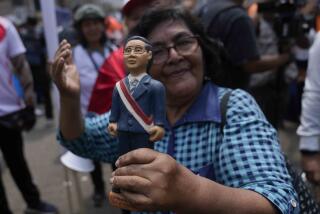The Dismal Decade: Failure East and West
- Share via
As Russia’s economy spirals out of control this fall with a collapsed currency, default on foreign debts, a plummeting economy and the worst harvest in years, an assessment must be made of what went wrong with Russia’s reform process.
I served as an economic advisor to President Boris Yeltsin from November 1991 to January 1994. More than a few people have blamed my advice--a charge I must decline. The advice that I gave: Eliminate price controls, stop subsidies to loss-making state enterprises, make the currency convertible and open the economy to trade. This kind of economic medicine produced an end of hyperinflation and strong economic growth in Poland, Estonia, Slovenia and other economies that I advised.
The same advice would have worked in Russia, but it was not followed. My real frustration in Russia was not the failure of these suggestions, but the fact that the Russian government did not pursue real reforms.
The West bears a lot of responsibility for the failure of Russia to pursue these reforms. The Yeltsin government was financially and politically very weak. In the case of Poland, the West gave several critical kinds of help, including: the zloty stabilization fund, a time-out on debt-servicing payments, and a cancellation of half of Poland’s debts. But the hard-nosed Western attitudes weakened the Yeltsin government and eventually contributed to its collapse.
Additionally, the advice of the International Monetary Fund was atrocious. Someday some serious historians will get a look at the IMF’s books and see the utter incompetence of that institution’s advice and behavior in Russia. The IMF convinced the Russians not to introduce a separate national currency in 1992. The fact that all 15 successor states of the Soviet Union shared a currency in 1992 meant that each of the new countries introduced highly inflationary monetary policies, since the inflationary effects were absorbed by the other countries.
Also, the Russians were highly corrupt, especially after the end of the Gaidar government in 1992. Viktor Chernomyrdin presided over one of the most corrupt privatization processes in world history. Tens of billions of dollars of natural resource exports were given away free to politically connected insiders in the Russian regime.
The U.S. administration just stood by as this corruption continued. Nobody in the U.S. or the IMF wanted to hear a bad word about the Chernomyrdin government. That government was on our side, it was said repeatedly. The corruption poisoned the Russian political process, but nobody in the Western leadership wanted to say a word about it at the time.
In the end, the corruption and the lack of reform undermined the Russian fiscal system. The government could not or would not collect taxes, especially from politically powerful firms. Nor did the government raise revenues by selling its valuable natural resources; instead they gave them away. In the end, the government went bankrupt.
For two years, the government borrowed heavily from foreign investors by selling them the now-famous ruble-denominated Treasury bills. Foreign investors put lots of money into these treasury bills because they thought that the IMF would always bail out Russia if necessary. They were almost correct. The IMF put in $22 billion in emergency loans, but it wasn’t enough, given the extensive rot of the Russian fiscal system.
Why did the Russians allow this to happen to their society?
Almost nobody in Russia knew anything about democracy or market economy. Unlike Poland, which had national traditions and experience in both, Russia simply lacked the historical knowledge and trained personnel to manage a market economy. The situation was even worse than in China, which still had people familiar with trade and commerce from before the 1949 communist revolution.
Also, Russia is more geographically isolated from Western markets than is Central Europe or China. Russia has no large coastal economy, for example, which has been the real fuel of China’s rapid growth. Russia has little direct economic contact with Western Europe, except through natural resource exports. Transport costs between Western Europe and Moscow are much higher than between Western Europe and locations in Central Europe.
Third, Russia lacks a civil society. Most of it was killed off by Lenin, Stalin and their successors. There are no powerful organizations independent of the state, such as the Catholic Church or the Solidarity Trade Union movement in Poland. The result is that the Russian government is not constrained in its actions by independent power centers. When the government engages in full-scale corruption, no one is powerful enough to protest.
Lastly, Russia did not experience a complete political change as did Central Europe. Even though the Soviet Union disintegrated, many of the key institutions of the Communist era were maintained. The Communist Party continued to have authority and a presence.
This has been a dismal decade for Russia. Economic decline has accelerated. The early years of democracy have produced economic chaos. The West has failed to provide useful support.
The situation is dire, but not lost. Russia is still maintaining its new and fragile democratic institutions. This gives some hope for continued peaceful change. After years of failed Western support, let’s take the IMF out of the picture and start a new and fresh approach to support for Russia.
More to Read
Sign up for Essential California
The most important California stories and recommendations in your inbox every morning.
You may occasionally receive promotional content from the Los Angeles Times.













